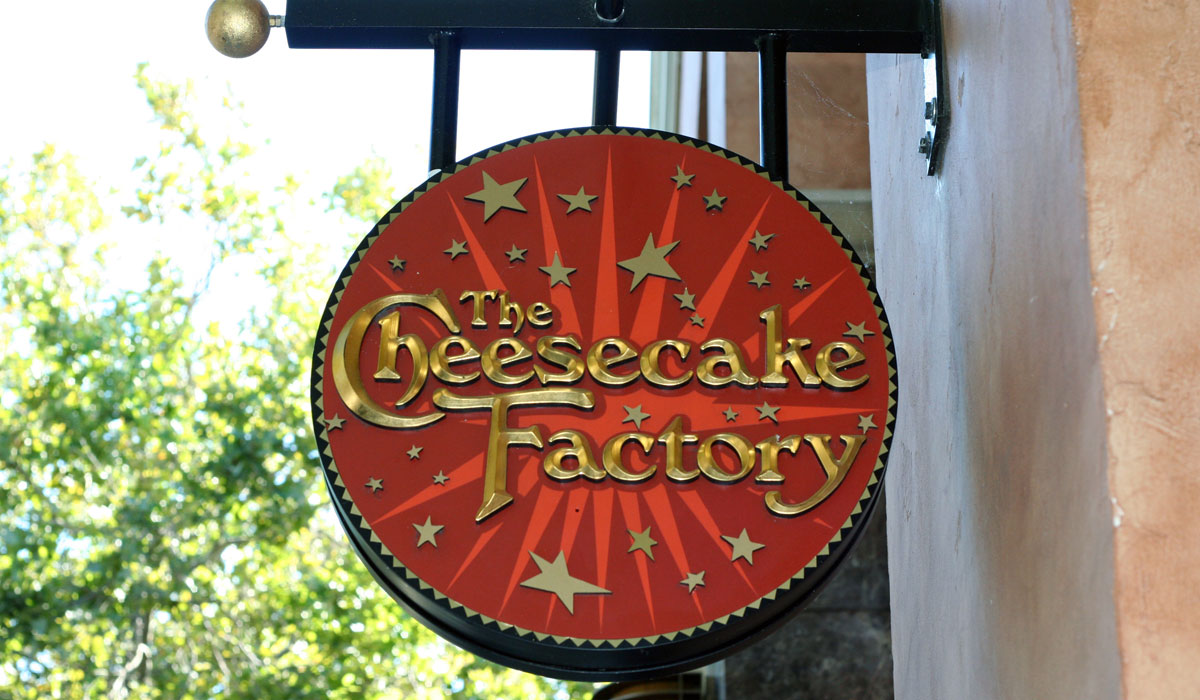After 29 consecutive positive quarters of sales growth, The Cheesecake Factory has started another streak—one it hopes to remedy sooner than later. For the second straight quarter, the chain reported negative same-store sales. Comps fell 2.3 percent in the third quarter, year-over-year, after dropping 0.5 percent in the previous quarter.
This number, The Cheesecake Factory pointed out, was inflated by volatile hurricane activity. Hurricanes Harvey, Irma, and Maria produced a negative impact of about 0.8 percent, the chain said. Excluded, same-store sales declined 1.5 percent.
Total revenues were $555.4 million in the third quarter compared to $560 million in the same period last year. Net income and diluted net income per share were $26.4 million and 56 cents, respectively. The results fell short of Wall Street expectations, which called for earnings of 60 cents per share and revenue of $562.5 million, according to seven analysts surveyed by Zacks.
Shares were down more than 7 percent in pre-market trading Thursday. They have dropped 25 percent since the start of 2017 and are down 15 percent in the past 12 months.
David Overton, chairman and chief executive officer, said in a conference call that all staff members are safe and none of the restaurants sustained significant damage from the storms. He said the brand met its sales and earnings expectations if you exclude the impact. “As we look forward, we are continuing to invest in the guest experience, which we believe is contributing to stabilization of our underlying sales trends,” he said.
Executives said in the call that core guests are still fueling the brand, and that The Cheesecake Factory hasn’t lost its loyal base. Matthew Eliot Clark, executive vice president and chief financial office, said the company is rolling out some innovations to draw the crowd into the restaurant at even higher rates. “We think that the brand relevance is as high as ever based on the research that we’ve done, that our core guests really love us,” he said. “So there’s no doubt that we got impacted 1 to 2 percent from some of this fringe as we’ve mentioned. The key is we’ve held on to our core guests. And so as consumer spending wallet shifts back a little bit toward restaurants, we’ll get our fair share of that as well.”
“I don’t think much has changed inside our four walls,” he added. “We continue to get great reviews. But if anything, we know we have to work a little bit harder, and we need to kind of recapture that 1 to 2 percent.”
As far as what this “fringe” refers to, there are several factors at play. One is the aforementioned consumer spending. Also, the overall decline in mall traffic and its related spending, which he estimated could be impacting the brand to the tune of 50–100 basis points. The brand’s traffic declined 4.3 percent in the quarter. Adjusted sans hurricane activity, it fell 3.5 percent.
In a sign of confidence for the future, The Cheesecake Factory didn’t change its development outlook. The company still plans to open eight company-owned stores this year. Additionally, it expects to debut four restaurants under licensing agreements internationally in fiscal 2017, including a second Qatar location that opened in September.
“We continue to believe there is potential for 300 domestic Cheesecake Factory locations,” Overton said. “We will invest capital in great sites that meet our rigorous standards, and we always look to balance our ongoing capital allocation decisions with the intent to generate the best long-term returns figures.”
The Cheesecake Factory is pushing deeper into off-premises dining. Delivery via a third-party provider is currently available at about 70 percent of locations. In October, the company entered into an agreement with a second provider, and expects about 85 percent of restaurants to offer delivery by the end of 2017. Overton said 90 percent should be on board by the first half of 2018.
In line with the rollout, The Cheesecake Factory is improving to-go ordering. It hopes to pilot online ordering by the end of the year. “We believe this will be another contributor to support continued growth of our strong off-premise sales,” he said.
Another traffic initiative is The Cheesecake Factory’s expansion of Saturday brunch. “Our guest has been asking for it. And with breakfast a growing daypart for the broader industry, we felt that now was a great time to expand this offering,” Overton said.
The Cheesecake Factory also launched a platform that leverages the net promoter methodology across its restaurants. The chain partnered with a leading provider to deliver the restaurant actionable insights “to better understand what opportunities need to be addressed while reinforcing positive staff behaviors to further promote memorable dining occasions at The Cheesecake Factory and drive sales.”
Clark said while the third quarter was challenging, given the hurricanes and industry headwinds, The Cheesecake Factory’s underlying sales fundamentals are improving.
“I think the quarter, as most people know in the industry, was a little bit volatile particularly at the start. But I think indicative of the guidance that we’re providing for Q4 and next year, we feel that there’s an improving trend in our business,” he said. “… Obviously, there are still some headwinds, but I think for us, at least, we’re starting to see it moving in the right direction.”
As for the mall topic, which has been a recurrent one in recent quarters, Clark said core guests continue to find their way into the restaurant. The issue is economically focused diners, who “might have been pulling back a little bit and that also might be where some of the mall traffic has been down,” he said.
“I do think there’s been some good sell side research that suggests for us maybe it’s 50 to 100 basis points of pressure at the low point in this environment,” Clark said. “And do we think that we can recover that? I think we do.”









